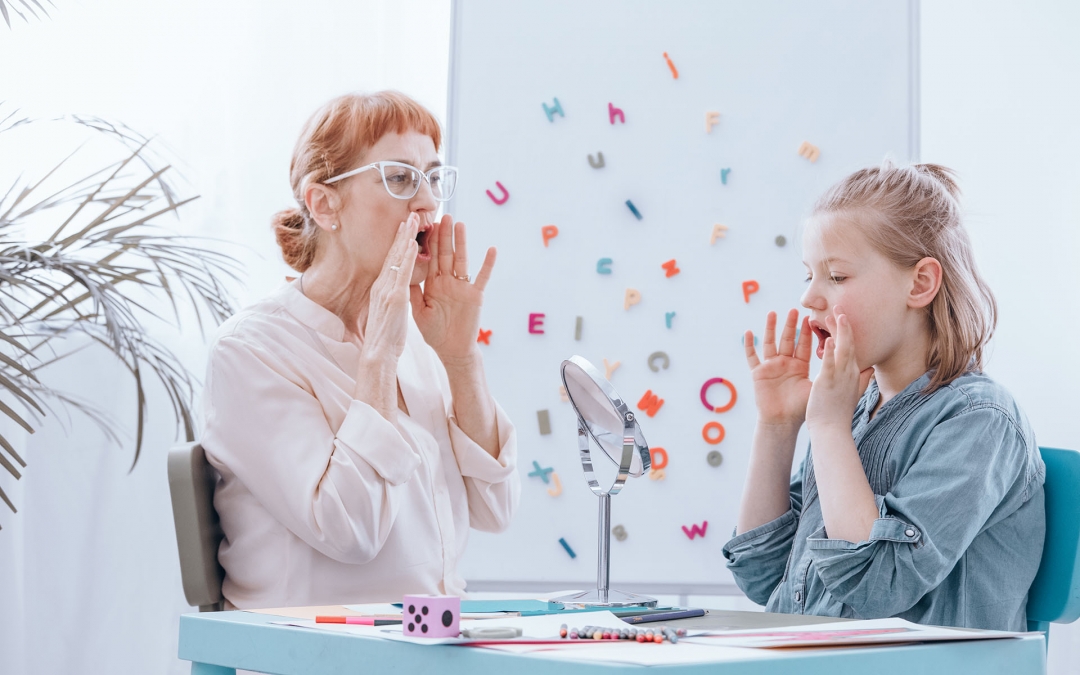There are major differences in the areas of speech and language. However, both areas are equally important. Speech is how we produce words and sounds. Language refers to how we use these words in order to communicate our wants and needs.
There are three different areas to consider when talking about speech: articulation, voice, and fluency.
What is Articulation?
Articulation refers to how we make speech sounds using our tongue, lips, and mouth. We need to be able to produce different sounds in order to form words and communicate. Children or adults can have difficulty with producing speech sounds for a variety of reasons. Speech sound disorders fall into two categories: organic speech sound disorders or functional speech sound disorders. Organic speech sound disorders are the result of a motor/neurological, structural or sensory cause. Examples of motor/neurological speech sound disorders include childhood apraxia of speech and dysarthria. Structural speech sound disorders could be caused by cleft palate or other structural abnormalities of the articulators (lips, tongue, etc.). Sensory speech sound disorders would include hearing impairment. Functional speech sound disorders have no known cause. Functional speech sound disorders are the result of errors in the motor production of sounds or linguistics of speech. Typically, functional speech sound disorders are also known as articulation or phonological disorders. Articulation disorders commonly refer to errors in words like substitutions of one sound for another. Phonological disorders focus on errors in the rules of speech. For example, fronting is considered a phonological disorder. Fronting is where a sound made in the back of the mouth (K,G) is replaced with a sound made in the front of the mouth (T,D).
What is Voice?
Voice refers to how we combine our vocal cords and breathing in order to make sounds. Our voice can be different volumes and pitches, and just like any other part of the body the vocal cords can be damaged. Voice disorders can occur when the quality, pitch and volume of the voice is considered inappropriate for the individual’s age, gender and culture. Voice disorders can be caused by a variety of different reasons including: organic, structural, neurogenic, and functional. Organic voice disorders result from changes in the respiratory, laryngeal or vocal tracts. Organic voice disorders include structural and neurogenic causes as well. Structural disorders of the voice result from physical changes to the voice cause as vocal nodules. Neurogenic voice disorders are caused by central or peripheral nervous system problems related to how they connect to the larynx. Examples of neurogenic voice disorders include spasmodic dysphonia or paralysis of the vocal cords. Voice disorders can also be functional in nature. This means that the voice disorder is the result of misuse of the vocal cords. Examples of functional voice disorders include muscle tension dysphonia and aphonia. Overlap of the type of voice disorders is common.
What is Fluency?
Fluency is the rhythm of speech. It refers to how continuous, smooth, and how fast or slow a person speaks. When someone has difficulty with fluency, there are interruptions in the normal flow of speech. This is often noted by disfluencies (repeating sounds or words, blocks), tension, and atypical rate or rhythm of speech. There are two common types of fluency disorders: stuttering and cluttering. Stuttering is typically characterized by disfluencies such as: repetitions of sounds/words (m-m-m-mom), prolongations of sounds (Sssssssssstay home), or blocks (inability to get sound out). Disfluencies impact the rate and rhythm of speech and can be accompanied by avoidance behaviors (avoiding words, people or situations), escape behaviors (frequent eye blinking, body movements), and physical tension. Often, stuttering begins in early childhood (before 4) and can be sudden or progressive. Stuttering can co occur with other disorders as well. Cluttering is another type of fluency disorder. Cluttering is typically characterized by rapid, irregular speech, excessive disfluencies, omission of syllables, and a breakdown in clarity of speech. Often, individuals are not aware of breakdowns in communication and this can impact social interactions. Typically, children are diagnosed in late childhood or early adulthood. Cluttering can also occur with other diagnoses.
Receptive Language and Expressive Language
There are two areas of language. Receptive language and expressive language. Receptive language is how we understand what is being said to us. Expressive language is how we share our thoughts, wants, and ideas with others. For example, language includes:
- What words mean
- How to make new words
- Putting words together
- Understanding concepts like same/ different
- Social communication
- Reading and writing
Individuals with language delays can occur with conditions such as autism, ADHD, TBI, hearing loss, etc. Language disorders can also occur with no other known conditions. This is referred to as a specific language impairment (SLI). Often, children that have reading and writing difficulties have difficulty with spoken language skills and vice versa. Children with SLI can also have difficulty with pragmatic skills (social interaction and communication). Language disorders can occur early on. Often, parents notice language disorders around the time their children are starting preschool (3-5). Some signs of language delay in preschool children are difficulty: understanding spoken language, following directions, pointing to named objects, taking turns in conversation and answering questions. Signs of an expressive language delay in preschool aged children are difficulty: naming objects, asking questions, forming sentences, using pronouns correctly, initiating and maintaining conversations. Children that display language disorders early on may continue to have persistent language disorders as they grow up. Some signs of language delays in older children are: difficulty with word finding, difficulty understanding and using complex sentences and language forms, difficulty with reading and writing, many grammatical errors in speaking and writing, etc.
Niagara Therapy, LLC specializes in speech therapy for both kids and adults in Erie, PA. Our speech therapists offer advanced interventions for assembling thoughts and organizing speech. If you or your child is struggling with speech or language development, contact one of our speech therapists to schedule a consultation.



